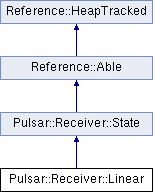 PSRCHIVE
PSRCHIVE
| Ask a Question | Search PSRCHIVE: |
 PSRCHIVE
PSRCHIVE
| Ask a Question | Search PSRCHIVE: |
 Home Home
|
Pulsar::Receiver::Linear Class Reference Stores the X and Y receptor and calibrator orientations. More...
Inheritance diagram for Pulsar::Receiver::Linear:

Detailed DescriptionStores the X and Y receptor and calibrator orientations. Member Function Documentation◆ copy()
Copy the state from another. Implements Pulsar::Receiver::State. References calibrator_offset, Pulsar::Receiver::set_calibrator_offset(), Pulsar::Receiver::state, x_offset, and y_offset. ◆ get_basis()
Get the basis of the feed receptors. Implements Pulsar::Receiver::State. ◆ get_hand()
Get the hand of the basis. Return true if the basis is right-handed. Implements Pulsar::Receiver::State. References y_offset. ◆ get_orientation()
Get the orientation of the basis about the line of sight. Implements Pulsar::Receiver::State. ◆ get_reference_source_phase()
Get the phase of the reference source. Implements Pulsar::Receiver::State. References calibrator_offset, and y_offset. ◆ set_calibrator_offset()
Set the offset of the feed calibrator axis from its nominal value. In the linear basis, the noise diode must illuminate both receptors equally. Therefore, there are only two valid orientations:
References calibrator_offset. ◆ set_Y_offset()
Set the offset of the feed Y axis from its nominal value. In the right-handed basis, the Y axis points in the direction of East. However it is also common to encounter systems in which the Y axis is offset by 180 degrees, pointing West. This is equivalent to switching the sign of the Y probe, which amounts to a 180 degree rotation of the Stokes vector about the Q axis. It is also equivalent to the product of:
which is how the transformation is represented by this class.
References y_offset. The documentation for this class was generated from the following files:
Generated using doxygen 1.14.0
|
||||||||||||||||||||||||||||||||||||||||||||||||||||||||||||||||||||||||||||||||||||||||||||||||||||||||||||||||||||||||||||||||||||||||||||||||||||||||||